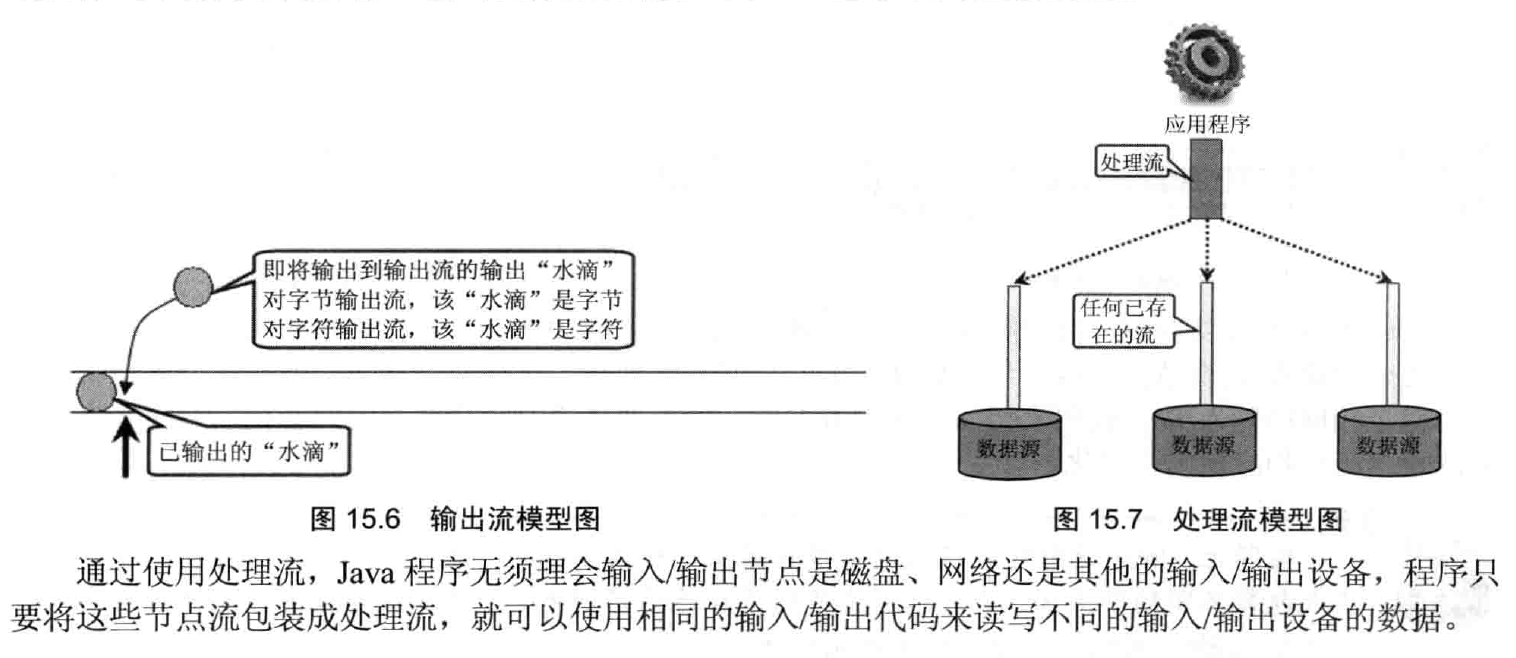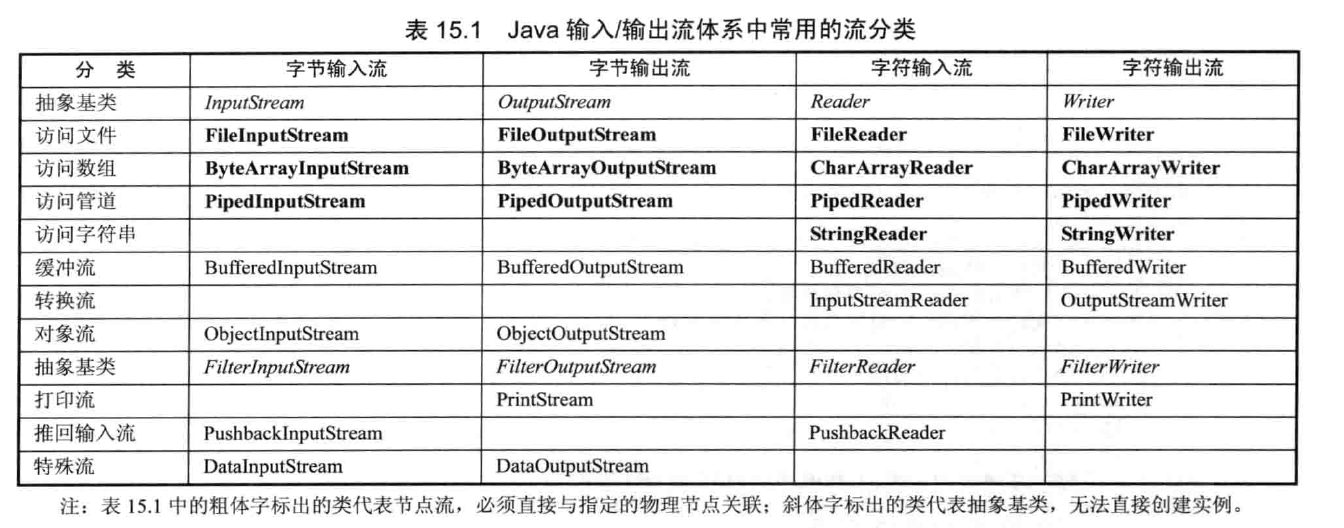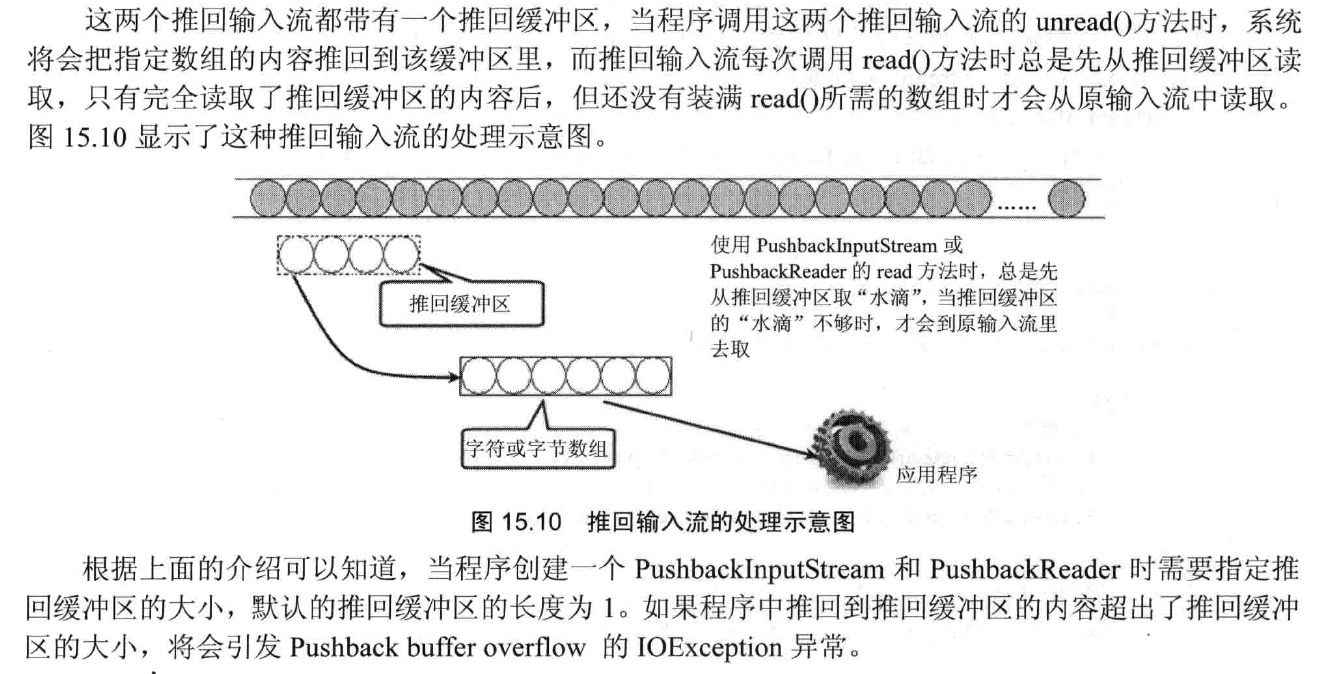java8--IO(java疯狂讲义3复习笔记)

产生文件
File file = new File("abc.txt"); if(!file.exists()){ System.out.println(file.exists()); file.createNewFile(); } System.out.println(file.getAbsolutePath());
关于临时文件
1).放在指定目录,此时已项目为默认目录
File file = File.createTempFile("defaultTmp","tmpp",new File("./")); System.out.println(file.getAbsolutePath());
--------------------------------------------------
/Users/liuxin/work/workspace2/learnJava/./defaultTmp5487876755372558069tmpp
2).放在默认目录
File file = File.createTempFile("defaultTmp",".tmpp"); System.out.println(file.getAbsolutePath()); ------------------------------------------------------------------------ /var/folders/f9/x95426d95ng7wgy7f7yccj3w0000gn/T/defaultTmp1175907986750188229tmpp
3).虚拟机退出时删除临时文件
File file = File.createTempFile("defaultTmp",".tmpp"); file.deleteOnExit(); System.out.println(file.getAbsolutePath());
4).关于后缀
File testFile = new File("testFile"); if(!testFile.exists()){ testFile.mkdirs(); } testFile.deleteOnExit(); File file = File.createTempFile("defaultTmp","tmpp"); System.out.println(file.getAbsolutePath()); File file2 = File.createTempFile("defaultTmp2",".tmpp",testFile); System.out.println(file2.getAbsolutePath()); File file3 = File.createTempFile("defaultTmp3",null,testFile); System.out.println(file3.getAbsolutePath()); ======================================= /var/folders/f9/x95426d95ng7wgy7f7yccj3w0000gn/T/defaultTmp5296324826431648502tmpp /Users/liuxin/work/workspace2/learnJava/testFile/defaultTmp21551336802243345058.tmpp /Users/liuxin/work/workspace2/learnJava/testFile/defaultTmp33930717872920538957.tmp
操作目录
1.查看目录下的所有文件
File currentFile = new File("."); System.out.println(currentFile.getAbsolutePath()); for(File file : currentFile.listFiles()){ System.out.println(file.getName()); }

getParent()的使用方法
File file = new File("."); System.out.println(file.getAbsolutePath()); System.out.println(new File(file.getAbsolutePath()).getParent()); ----------------------- /Users/liuxin/work/workspace2/learnJava/. /Users/liuxin/work/workspace2/learnJava getParent()只有在定义文件时有路径时才起作用.
15.2 流
字节流主要由InputStream和OutputStream作为基类,而字符流则主要由Reader和Writer作为基类.
字节流操作的数据单元是8位的字节,而字符流操作的数据单元是16位的字符
节点流和处理流,节点流是低级流,直接跟数据源相接.处理流(也叫包装流)把节点流包装了一层,属于修饰器设计模式.
处理流的功能主要体现在以下两个方面:
1.性能的提高:主要以增加缓冲的方式来提高输入输出的效率
2.操作的便捷:处理流可能提供了一系列便捷的方法来一次输入输出大批量的内容,而不是输入/输出一个或多个水滴
处理流可以嫁接在任何已存在的流的基础上.

15.3.1 InputStream和Reader
InputStream和Reader是所有输入流的抽象基类,本身并不能创建实例来执行.
读取文件的demo
public static void testFile() throws IOException{ // 创建字节输入流 FileInputStream fis = new FileInputStream("a.txt"); // 创建一个长度为1024的“竹筒” byte[] bbuf = new byte[1024]; // 用于保存实际读取的字节数 int hasRead = 0; // 使用循环来重复“取水”过程 while ((hasRead = fis.read(bbuf)) > 0 ) { // 取出“竹筒”中水滴(字节),将字节数组转换成字符串输入! System.out.print(new String(bbuf , 0 , hasRead )); } // 关闭文件输入流,放在finally块里更安全 fis.close(); }
关于fileFilter

File file = new File("."); String[] nameList = file.list((dir, name) -> name.endsWith(".java") || new File(name).isDirectory()); for(String name : nameList) { System.out.println(name); } ================================ .settings a bin lib result sqlModify src testFile
15.2 理解java的IO流

用字节流读取文件并打印
public static void testFile2() throws IOException{ // 创建字节输入流 FileInputStream fis = new FileInputStream("a.txt"); //读取一个字节,返回的是int,所以要用char强转 System.out.println((char)fis.read()); // 创建一个长度为1024的“竹筒” byte[] bbuf = new byte[1024]; //读取5个字节,放在bbuf的index为10的位置 fis.read(bbuf,10,10); // 从bbuf中index为10的位置读取5个字节构成字符串 System.out.println(new String(bbuf , 10, 5)); //转换成String后,byte[]不变 System.out.println(new String(bbuf , 10, 5)); // 用于保存实际读取的字节数 int hasRead = 0; // 使用循环来重复“取水”过程 while ((hasRead = fis.read(bbuf)) > 0 ) { //重新赋值后,byte[]会改变 System.out.println(new String(bbuf , 10, 5)); // 取出“竹筒”中水滴(字节),将字节数组转换成字符串输入! System.out.println("=============================================="); String test = new String(bbuf , 0 , hasRead ); System.out.println(test); System.out.println("=================="+new String(bbuf , 0 , hasRead ).length()+"============================"); } // 关闭文件输入流,放在finally块里更安全 fis.close(); }
打印结果如下
< ?xml ?xml ncodi ============================================== on="1.0" encoding="UTF-8"?> <projectDescription> <name>learnJava</name> <comment></comment> <projects> </projects> <buildSpec> <buildCommand> <name>org.eclipse.jdt.core.javabuilder</name> <arguments> </arguments> </buildCommand> </buildSpec> <natures> <nature>org.eclipse.jdt.core.javanature</nature> </natures> </projectDescription> 我很好啊,看看需不要utf-8 ==================373============================
public static void testFile3() { try( // 创建字符输入流 FileReader fr = new FileReader("a.txt") ){ // 创建一个长度为32的“竹筒” char[] cbuf = new char[32]; System.out.println(fr.read(cbuf,0,32)); System.out.println(new String(cbuf)); // 用于保存实际读取的字符数 int hasRead = 0; // 使用循环来重复“取水”过程 while ((hasRead = fr.read(cbuf)) > 0 ) { // 取出“竹筒”中水滴(字符),将字符数组转换成字符串输入! // System.out.print(new String(cbuf , 0 , hasRead)); System.out.print(new String(cbuf)); } } catch (IOException ex) { ex.printStackTrace(); } }

outPutStream 和 Writer
public static void testFileWriter() {
//这里a.txt可以不存在,如果不存在回自动生成,但是没搞明白怎么设置编码格式 try(FileWriter fw = new FileWriter("a.txt")) { fw.write("锦瑟 - 李商隐\r\n"); fw.write("锦瑟无端五十弦,一弦一柱思华年。\r\n"); fw.write("庄生晓梦迷蝴蝶,望帝春心托杜鹃。\r\n"); fw.write("沧海月明珠有泪,蓝田日暖玉生烟。\r\n"); fw.write("此情可待成追忆,只是当时已惘然。\r\n"); } catch (IOException ioe) { ioe.printStackTrace(); } }

15.4 输入输出流体系
处理流:构造参数是已经存在的流.
节点流:构造参数是物理IO节点
处理流的用法
public static void PrintStream() { try( FileOutputStream fos = new FileOutputStream("a.txt"); PrintStream ps = new PrintStream(fos)) { // 使用PrintStream执行输出 ps.println("普通字符串"); // 直接使用PrintStream输出对象 ps.println(new LearnIO()); } catch (IOException ioe) { ioe.printStackTrace(); } }
输出结果
普通字符串
learnIO.LearnIO@677327b6
在使用了处理流包装了底层节点之后,关闭输入/输出流资源时,只要关闭最上层的处理流即可。关闭最上层的处理流时,系统会自动关闭被该处理流包装的节点流。

字符串流的用法,似乎没什么用,等发现用处再补充
public static void stringNodeTest() { String src = "从明天起,做一个幸福的人\n" + "喂马,劈柴,周游世界\n" + "从明天起,关心粮食和蔬菜\n" + "我有一所房子,面朝大海,春暖花开\n" + "从明天起,和每一个亲人通信\n" + "告诉他们我的幸福\n"; char[] buffer = new char[32]; int hasRead = 0; try( StringReader sr = new StringReader(src)) { // 采用循环读取的访问读取字符串 while((hasRead = sr.read(buffer)) > 0) { System.out.print(new String(buffer ,0 , hasRead)); } } catch (IOException ioe) { ioe.printStackTrace(); } try( // 创建StringWriter时,实际上以一个StringBuffer作为输出节点 // 下面指定的20就是StringBuffer的初始长度 StringWriter sw = new StringWriter()) { // 调用StringWriter的方法执行输出 sw.write("有一个美丽的新世界,\n"); sw.write("她在远方等我,\n"); sw.write("哪里有天真的孩子,\n"); sw.write("还有姑娘的酒窝\n"); System.out.println("----下面是sw的字符串节点里的内容----"); // 使用toString()方法返回StringWriter的字符串节点的内容 System.out.println(sw.toString()); } catch (IOException ex) { ex.printStackTrace(); } }
15.4.3 转换流
InputStreamReader :将字节输入流转换成字符输入流
OutputStreamWriter:将字节输出流转换成字符输出流
经过测试,下面这个程序是有一定问题的,用输入法的时候,会重复输出好多遍
public static void KeyinTest() { try( // 将Sytem.in对象转换成Reader对象 InputStreamReader reader = new InputStreamReader(System.in); // 将普通Reader包装成BufferedReader BufferedReader br = new BufferedReader(reader)) { String line = null; // 采用循环方式来一行一行的读取 while ((line = br.readLine()) != null) { // 如果读取的字符串为"exit",程序退出 if (line.equals("exit")) { System.exit(1); } // 打印读取的内容 System.out.println("输入内容为:" + line); } } catch (IOException ioe) { ioe.printStackTrace(); } }
15.4.4 推回输入流
PushbackInputStream和PushbackReader
用unread方法将内容推回到缓冲区,从而允许重复读取刚刚读取的内容.

使用推回流,输出某分割符号之前的内容。但其实完全不必这么做,读出来判断就好了。
public static void pushbackTest() { try( // 创建一个PushbackReader对象,指定推回缓冲区的长度为64 PushbackReader pr = new PushbackReader(new FileReader("a.txt") , 64)) { char[] buf = new char[32]; // 用以保存上次读取的字符串内容 String lastContent = ""; int hasRead = 0; // 循环读取文件内容 while ((hasRead = pr.read(buf)) > 0) { // 将读取的内容转换成字符串 String content = new String(buf , 0 , hasRead); int targetIndex = 0; // 将上次读取的字符串和本次读取的字符串拼起来, // 查看是否包含目标字符串, 如果包含目标字符串 if ((targetIndex = (lastContent + content) .indexOf("测试")) > 0) { // 将本次内容和上次内容一起推回缓冲区 pr.unread((lastContent + content).toCharArray()); // 重新定义一个长度为targetIndex的char数组 if(targetIndex > 32) { buf = new char[targetIndex]; } // 再次读取指定长度的内容(就是目标字符串之前的内容) pr.read(buf , 0 , targetIndex); // 打印读取的内容 System.out.print(new String(buf , 0 ,targetIndex)); System.exit(0); } else { // 打印上次读取的内容 System.out.print(lastContent); // 将本次内容设为上次读取的内容 lastContent = content; } } } catch (IOException ioe) { ioe.printStackTrace(); } }
system类里提供了三个重定向标准输入输出的方法。
setErr(PrintStream err)
setIn(InputStream in)
setOut(PrintStream out)
程序可通过重定向标准输出流,将System.out的输出重定向到文件输出.
15.6 Java虚拟机读写其他进程的数据
使用Runtime对象的exec()方法可以运行平台上的其他程序,该方法产生一个Process对象,Process对象代表由该Java程序启动的子进程.Process类提供了如下三个方法,用于让程序和其子进程进行通信.
InputStream getErrorStream():获取子进程的错误流,
InputStream getInputStream(): 获取子进程的输入流.
OutputStream getOutputStream(): 获取子进程的输出流.
这里的输入流和输出流是相对于该java程序(注意,不是子程序)而言的.这里的子进程相当于物理节点
注意,这里用的是getErrorStream(),因为这不是子进程向本进程传递的数据,所以属于其他,要用ErrorStream
public static void readFromProcess() throws IOException { // 运行javac命令,返回运行该命令的子进程 Process p = Runtime.getRuntime().exec("java -version"); try( // 以p进程的错误流创建BufferedReader对象 // 这个错误流对本程序是输入流,对p进程则是输出流 BufferedReader br = new BufferedReader(new InputStreamReader(p.getErrorStream()))) { String buff = null; // 采取循环方式来读取p进程的错误输出 while((buff = br.readLine()) != null) { System.out.println(buff); } } }
java version "1.8.0_51" Java(TM) SE Runtime Environment (build 1.8.0_51-b16) Java HotSpot(TM) 64-Bit Server VM (build 25.51-b03, mixed mode)
java两个程序之间传递信息:这端代码我没跑起来,待研究
public class WriteToProcess { public static void main(String[] args) throws IOException { // 运行java ReadStandard命令,返回运行该命令的子进程 Process p = Runtime.getRuntime().exec("java ReadStandard"); try( // 以p进程的输出流创建PrintStream对象 // 这个输出流对本程序是输出流,对p进程则是输入流 PrintStream ps = new PrintStream(p.getOutputStream())) { // 向ReadStandard程序写入内容,这些内容将被ReadStandard读取 ps.println("普通字符串"); ps.println(new WriteToProcess()); } } } // 定义一个ReadStandard类,该类可以接受标准输入, // 并将标准输入写入out.txt文件。 class ReadStandard { public static void main(String[] args) { try( // 使用System.in创建Scanner对象,用于获取标准输入 Scanner sc = new Scanner(System.in); PrintStream ps = new PrintStream( new FileOutputStream("out.txt"))) { // 增加下面一行将只把回车作为分隔符 sc.useDelimiter("\n"); // 判断是否还有下一个输入项 while(sc.hasNext()) { // 输出输入项 ps.println("键盘输入的内容是:" + sc.next()); } } catch(IOException ioe) { ioe.printStackTrace(); } } }
15.7 RandomAccessFile
RandomAccessFile可以自由访问文件的任意位置,所以如果只需要访问文件部分内容,而不是把文件从头读到尾,使用RamdomAccessFile将是更好的选择.但是局限是,它只能读写文件,不能读写其他IO节点.
getFilePointer():返回文件记录指针的当前位置
seek(long pos):将文件记录指针定位到pos位置
public static void randomAccessFileTest(){ try( RandomAccessFile raf = new RandomAccessFile( "newFile.txt" , "r")) { // 获取RandomAccessFile对象文件指针的位置,初始位置是0 System.out.println("RandomAccessFile的文件指针的初始位置:" + raf.getFilePointer()); // 移动raf的文件记录指针的位置 raf.seek(30); byte[] bbuf = new byte[1024]; // 用于保存实际读取的字节数 int hasRead = 0; // 使用循环来重复“取水”过程 while ((hasRead = raf.read(bbuf)) > 0 ) { // 取出“竹筒”中水滴(字节),将字节数组转换成字符串输入! System.out.print(new String(bbuf , 0 , hasRead )); } } catch (IOException ex) { ex.printStackTrace(); } }
RandomAccessFile 依然不能向文件的指定位置插入内容,如果直接将文件记录指针移动到中间某位置后开始输出,则新输出的内容会覆盖文件中原有的内容,如果需要向指定位置插入内容,程序需要先把插入点后面的内容读入缓冲区,等把需要插入的数据写入文件后,再将缓冲区的内容追加到文件的后面.
public static void insert(String fileName , long pos , String insertContent) throws IOException { File tmp = File.createTempFile("tmp" , null); tmp.deleteOnExit(); try( RandomAccessFile raf = new RandomAccessFile(fileName , "rw"); // 使用临时文件来保存插入点后的数据 FileOutputStream tmpOut = new FileOutputStream(tmp); FileInputStream tmpIn = new FileInputStream(tmp)) { raf.seek(pos); // ------下面代码将插入点后的内容读入临时文件中保存------ byte[] bbuf = new byte[64]; // 用于保存实际读取的字节数 int hasRead = 0; // 使用循环方式读取插入点后的数据 while ((hasRead = raf.read(bbuf)) > 0 ) { // 将读取的数据写入临时文件 tmpOut.write(bbuf , 0 , hasRead); } // ----------下面代码插入内容---------- // 把文件记录指针重新定位到pos位置 raf.seek(pos); // 追加需要插入的内容 raf.write(insertContent.getBytes()); // 追加临时文件中的内容 while ((hasRead = tmpIn.read(bbuf)) > 0 ) { raf.write(bbuf , 0 , hasRead); } } }
如果仅仅是追加内容,就简单多了
public static void main(String[] args) { try( //以读、写方式打开一个RandomAccessFile对象 RandomAccessFile raf = new RandomAccessFile("out.txt" , "rw")) { //将记录指针移动到out.txt文件的最后 raf.seek(raf.length()); raf.write("追加的内容!\r\n".getBytes()); } catch (IOException ex) { ex.printStackTrace(); } }
15.8 对象序列化(serialize)
对象的序列化指将一个java对象写入IO流中,与此对应的是,对象的反序列化(Deserialize)则指从IO流中恢复该java对象.
如果需要让某个对象支持序列化机制,那么必须让它的类是可序列化的,必须实现如下两个接口之一
Serializable
Externalizable
程序创建的每个JavaBean类都要实现Serializable
public static void writeObject() { try (ObjectOutputStream oos = new ObjectOutputStream( new FileOutputStream("obj.txt"));) { LearnIO learnIO = new LearnIO("12334444444"); oos.writeObject(learnIO); } catch (IOException ex) { // TODO: handle exception ex.printStackTrace(); } }
//但是,如果如下
LearnIO learnIO = new LearnIO("12334444444");
oos.writeObject(learnIO);
learnIO.test="abcdetc";
//不会写入abcdetc,因为不会序列化号码相同的东西
oos.writeObject(learnIO);
反序列化
public static void readObject(){ try( ObjectInputStream ois = new ObjectInputStream(new FileInputStream("obj.txt")); ){ LearnIO learnIO = (LearnIO)ois.readObject(); System.out.println(learnIO.test); }catch (Exception e) { // TODO: handle exception e.printStackTrace(); } }
反序列化机制无须通过构造器来初始化java对象.
如果使用序列化机制向文件中写入多个Java对象,使用反序列化机制恢复对象时必须按实际写入的顺序读取.
当一个可序列化类有多个父类时(包括直接父类和间接父类),这些父类要么有无参数的构造器,要么也是可序列化的--否则反序列化时将抛出InvalidClassException异常.如果父类是不可序列化的,只是带有无参数的构造器,则该父类中定义的成员变量值不会序列化到二进制流中.
15.8.3 对象引用的序列化
如果成员变量是引用类型,那么这个引用类型的类必须是可序列化的.
属于递归序列化
有static修饰和transient修饰的变量不会被序列化
15.8.4 自定义序列化
在实例变量前面使用transient关键字修饰,可以指定java序列化时无须理会该实例变量.
更详细的自定义序列化方法是重写writeObject和readObject方法.
15.8.5 另一种自定义序列化机制
实现Externalizable





